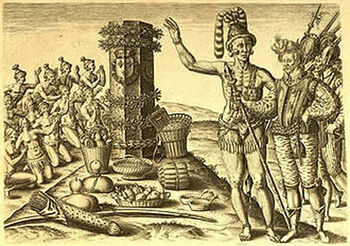A Tradition Is Born - The Early Years

Art and history are often referred to as “ A marriage made in Heaven” because they are so supportive of one another.Art, as a graphic record, becomes the means whereby we can see history. In return, history provides milestones or markers that give meaning to art. To fully appreciate art, to understand the styles and techniques used in its creation and to know what motivated the artists it’s helpful to place the art in an historic context.
There are periods and events in Florida’s history that can serve as markers for tracking Florida’s art tradition, the oldest in the new world. This continuing commentary uses the following.
Ch.1- The Early Years, The LeMoyne prints
Ch.2 - Art of The Colonial and Territorial Periods, 1513 - 1845
Ch.3 - Statehood and A Bit of Culture, 1845 - 1910
Ch.4 - Unexplored Territory, 1910 - 1950
Ch.5 - Florida Contemporary Art, 1950 - Present
The LeMoyne prints are named for Jacques LeMoyne de Morgues, a cartographer or map maker who accompanied the Frenchman Rene de Laudonniere to the new world to establish and maintain a French presence in 1564. It was LeMoyne’s duty to map the seacoasts and harbors, indicate the positions of towns, portray the natives, their dwellings and anything else worthy of observation. “All of this I performed to the best of my ability” wrote LeMoyne.
The Spaniards who had claimed Florida by the right of discovery, conquest and papal edict had no intention of sharing the newly discovered land with the French. The Spanish king, Philip the second, alarmed by the threat to his territory dispatched Pedro Menendez de Aviles to clear Florida of the French invaders in the summer of 1565. Menendez was equal to the task and Le Moyne was one of only a handful of Frenchmen who escaped with their lives. More of Le Moyne’s journey to and escape from the new world can be found in the book The New World - The First Pictures of America by Stefan Lorant.
It had been Le Moyne’s intention to publish a book with engravings made from his paintings. Unfortunately he died before the project could be completed. A Flemish engraver, Theodore de Bry purchased the paintings from Le Moyne’s widow and published a Florida volume with 43 copper plate engravings from Le Moyne’s art. It was De Bry’s effort that produced the series of engravings of the new world known as the
LeMoyne prints.
It’s interesting to note that only one of Le Moyne’s original paintings has survived. It was discovered in the private collection of an American collector in 1946.
